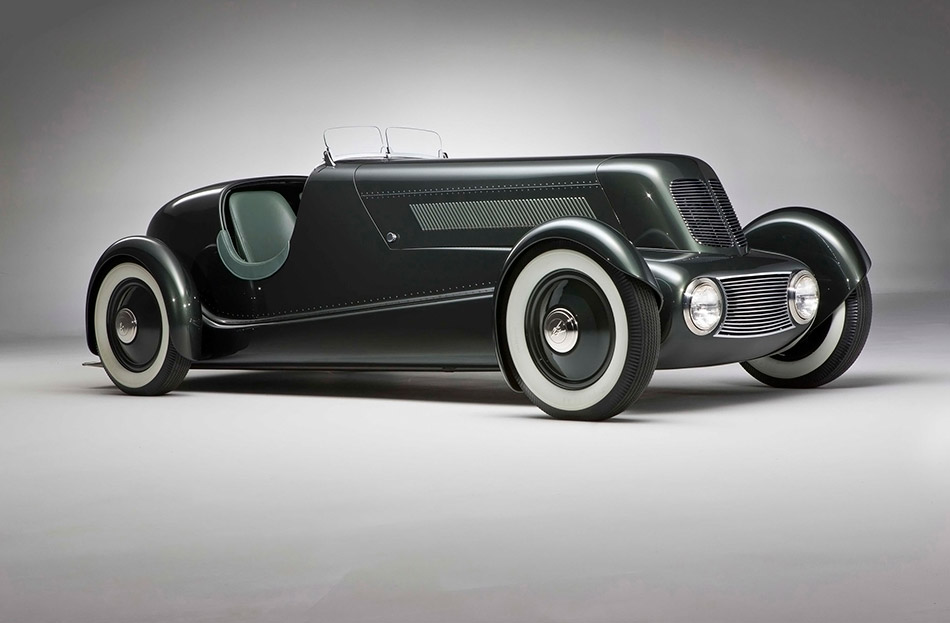Its rich history began in 1932 after Edsel returned from a trip to Europe. He asked Ford's chief designer, E.T. "Bob" Gregorie to design and supervise the construction of a personal sports car similar to those he'd see "on the continent."
The first design reportedly disappointed Edsel because it wasn't lower and racier. But Gregorie, who was adept at turning Edsel's visions into tangible designs, went to work on a more dramatic, streamlined design. This "continental" roadster may have started with a stock 1934 Ford (aka Model 40) frame, but its subsequent chassis was radically altered. The Model 40 Special Speedster was unlike anything Ford Motor Company had built up to that time.
At 113 inches, the Speedster's wheelbase is approximately the same as the standard 112-inch wheelbase of a 1934 Ford roadster. Yet, it appears longer and lower. This illusion was achieved by modifying and lowering the car's chassis, positioning the cockpit toward the rear of the car and extending the tail section.

Gregorie, Robbie Robinson, supervisor of the Lincoln plant, and Ford Aircraft Division personnel, fabricated a topless, taper-tailed aluminum body with cut-down door openings and mounted it over a custom welded tubular aluminum structural framework.
It was believed that the Speedster's fenders were modified Trimotor Aircraft "wheel pants," but Ford's aircraft fabricators undoubtedly fashioned them from scratch. The custom-designed front cycle wings were mounted so they turned with the car's Kelsey-Hayes wire wheels. The all-aluminum bodywork followed the best aircraft practice – light and very strong.
The Speedster was painted Pearl Essence Gunmetal Dark; the interior upholstered in complementary gray leather. The flat, engine-tuned instrument panel incorporated period Lincoln instruments. The 2,100-pound Speedster was powered by a stock 75-bhp, Ford Model 40 flathead, with straight exhausts that were enclosed by the bodywork with only the tips protruding.
The Speedster had low-mounted faired-in headlights, an enclosed radiator with a concealed cap, a starter button on the instrument panel, minimal chrome trim and no running boards – features that didn't appear on production Fords for years.
The Speedster's shapely hood had louvered side panels that subtly matched the angle of the radiator grille and the windscreen. A pair of narrow vee-ed grilles with a single row of louvers (vents) running the length of each side of the hood limited the flow of cooling air. The Speedster had a tendency to overheat.
Two period photographs of the car show two different louver treatments. One shows a single row of side louvers; the other features two rows of louvers, one atop the other. It's reasonable to suspect that because of overheating issues, the hood was modified between the times these photos were taken.
Reportedly, a winter freeze in 1939-40 cracked the engine block; a new 239-cid, 100-bhp 09A Mercury V-8 was installed. This would have been the most powerful version of the Ford flathead V-8 available at the time.
By 1939, Gregorie had designed wider twin grilles for the Lincoln-Zephyr, so it followed that he would take the same approach for the Speedster. He redesigned the Speedster's front end by shortening the upper grilles and fabricating a wide, horizontal grille for improved cooling. The new design, which required extensive modifications to the hood, was likely completed in 1940. The instrument panel may have been updated at the same time with a 160-mph racing type speedometer and matching Stewart-Warner accessory instruments.
"The Model 40 Special Speedster was only enjoyed by Edsel for a few short years before his death in 1943, but its journey was just beginning," said Ford House President Kathleen Mullins. "Ford House is proud to give life to Edsel's original vision for a unique, continental roadster."
The Model 40 Special Speedster has moved through almost eight decades of owners and modifications and has returned to its early design elegance. After Pebble Beach, its journey will continue, ultimately returning home . . . to Ford House.
Source: Ford














